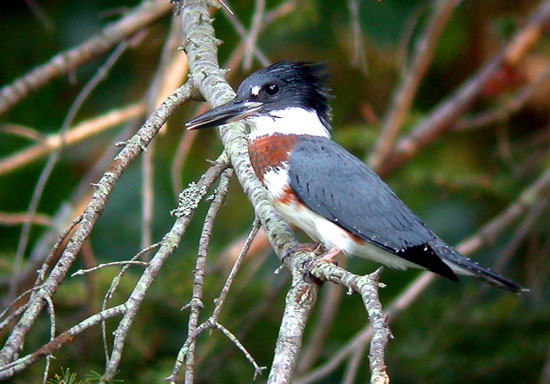- Megaceryle alcyon
Identification
- Big-headed and big-billed
- Larger than a Robin
- Blue-gray above
- Ragged bushy crest
- Broad gray breastband
Female
Has rufous breast band
Male
Lacks rufous breast band.
Distribution
Common and widespread over North America from southern Alaska east to Newfoundland (except parts of north-central Canada) and south to California and the Gulf Coast.
A partial migrant with most birds from the interior moving south in August-early November, returning in March-May, but some birds stay north in coastal areas. Winter range extends south to Mexico and Central America, the West Indies and northern South America. A common winter visitor and migrant to the Atlantic coast and regularly recorded on Bermuda.
Vagrants recorded in the Western Palearctic recorded in Iceland, Britain, Ireland and the Azores, with a record for the Netherlands. There have been five Icelandic records including at least two birds in May-September 1998, a moribund female in February 2002 and a male in October 2003. British Isles records (c.10), are mostly in Ireland in October-November but there are records for all months due to long-staying individuals, one for more than a year.
Habitat
Rivers and streams, lakes, ponds and along sea-coasts. Occurs up to 2,500m in the Rocky Mts.
Voice
A harsh, woody rattle
Behavior
Nesting
Nests in burrow in dirt banks
Taxonomy
Subspecies
West coast birds are sometimes separated as caurinus
Description
Hovering on rapidly beating wings in readiness for the plunge, or flying with uneven wingbeats (as if changing gear), rattling as it goes, the Kingfisher is easily recognized.
Perches conspicuously and fishes from a perch or hovers over the water.




